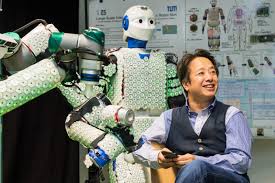Source: fastcompany.com
The robot itself looks like if you crossed Honda’s Asimo with the glowing gamepad from Dance Dance Revolution. In other words, it’s your typical, white plastic humanoid robot, but with a twist. Built as part of new research out of the Technical University of Munich, the H-1 is the first robot in history to be covered torso to toe in artificial skin. Its glowing, hexagonal coat actually allows it to feel, much like you or I can. And as a result, the robot can act a lot more human too.
With feeling in its arms and torso, the H-1 can hug people safely. Sensing the ground under its sole, the robot can easily balance on one foot. This sort of extreme sensitivity is something humans take for granted, and indeed it hasn’t really been necessary in the workhorse, industrial robots that weld steel and paint cars on assembly lines today. But as scientists imagine robots that might one day live among us and care for the sick or elderly, merely puppeting robots with perfectly choreographed movements or giving them exceptional vision technology isn’t enough. If robots are coming into constant contact with humans, this sort of physical empathy is necessary for safety.
Perhaps a robo skin of sensors sounds unimpressive at first. Sensors are commonplace these days, after all; we have multitudes of sensors, from temperature, to pressure, to positioning, in our phones. Each costs all of a few cents to acquire at the commercial scale.
But to create a skin of sensors is another whole magnitude of challenge. Humans have 5 million receptors on their skin, which have evolved to not crash our brains with massive cognitive loads every time we hop into the shower. To duplicate all of that sensation without the human brain is a monumental computing task, which would require “a building full of computers . . . for a single robot,” according to the project.
And make no mistake, there’s a lot of data for this robot to feel at any given moment. Each 1-inch hexagon you see in these images is loaded with proximity, pressure, temperature, and acceleration sensors, and connected to a dedicated processor to handle computations of this data. That’s a lot of computing, considering that the H-1 has 1,260 of these skin hexagons on its body, for a total of 13,000 sensors that could be firing at any moment.
But the new research worked around the limitations of computing with a few clever measures that are modeled after the human brain. An algorithm allows the skin cells to learn and normalize to their environment, tuning out everything but important changes. The researchers liken this approach to how you feel the sensation of putting on a shirt—after a few moments, your body more or less forgets you’re wearing it at all. You don’t keep thinking about your neckline and sleeves through the course of the day, which allows your nervous system to have the bandwidth to process the sensation of someone tapping you on the back. This biologically inspired approach allows researchers to drop the skin processing power by as much as 90%.
In any case, researchers plan to move forward with improving the skin design, which can be applied to many types of robots. The next challenge for researchers will be miniaturizing the skin cells and mass-producing them, while the next challenge for humans will be adjusting to a future in which every soda machine is trying to give you a free hug, all the time. Sure hope you enjoy the unique sensation of taking all our jobs, robots!


